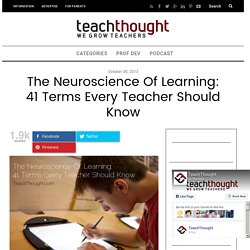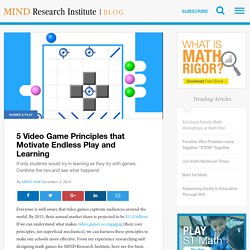

Six Strategies for Effective Learning — The Learning Scientists. References (1) Benjamin, A.

S., & Tullis, J. (2010). What makes distributed practice effective? The Challenges of Designing a Flipped Classroom in Higher Education. Student Challenges Moving from traditional to modern learning Not everybody is a fan of change, which can lead to some students pushing back against a flipped classroom course design.

For the most part, students are used to attending traditional lectures, taking notes and studying outside of class. What’s a Gamer Brain and How Can We Harness It in Class? In the past, I’ve written on ideas for gamification—using games in the classroom—but lately I’ve been reflecting on some of the bigger ideas that games open up in terms of pedagogy and the classroom experience.

While we can use games as tools and perhaps build units that are gamified, we might also adopt some basic ideas from the experience of playing games. Here are four takeaways from games that we can instill in our classrooms. Leverage the Gamer Brain. How Teachers Can Gamify Math – The Tech Edvocate. Study finds quality of research and teaching are not related. Skilled researchers and effective teachers are neither substitutes nor complements for each other -- in fact, they have no relationship at all, according to a study by two Northwestern University faculty published by the Brookings Institution Thursday.

Their research adds another perspective to a conversation that has troubled research universities for years: whether an emphasis on scholarship comes at a cost to quality instruction. “We are able to estimate with really quite impressive statistical precision that they aren’t related,” said Morton Schapiro, president and professor of economics at Northwestern and one of the authors of the study. Schapiro and his co-author David Figlio, who also teaches economics at Northwestern, evaluated data from all first-year undergraduates students at the university between 2001 and 2008. They measured teaching quality of tenured faculty two ways. First, they measured how “inspirational” a teacher is by the rate at which non-majors became majors. The Neuroscience Of Learning: 41 Terms Every Teacher Should Know. The Neuroscience Of Learning: 41 Terms Every Teacher Should Know by Judy Willis M.D., M.Ed., radteach.com As education continues to evolve, adding in new trends, technologies, standards, and 21st century thinking habits, there is one constant that doesn’t change.

The human brain. But neuroscience isn’t exactly accessible to most educators, rarely published, and when it is, it’s often full of odd phrasing and intimidating jargon. Worse, there seems to be a disconnect between the dry science of neurology, and the need teachers have for relevant tools, resources, and strategies in the classroom. As for the jargon, Judy Willis, teacher, neuroscientist, and consultant has put together an A-Z glossary of relevant neuroscience terms for teachers and administrators to help clarify the jargon.
The best approach with a list like this is to bookmark and share the page, and comeback to it intermittently. Baby steps. 41 Neuroscience Terms Every Teacher Should Know. Emerge talks EdTech with Tyler DeWitt – Emerge EdTech Insights – Medium. Dr Tyler DeWitt — founder of one of YouTube’s most successful education channels, high-school teacher and TED talk extraordinaire — talks to Emerge about his view on the future of education and learning.

Tell us about your YouTube channel ‘Science with Tyler DeWitt’ — how did it start and what problem does it solve? I started making these YouTube videos when I was a full time high school teacher. I had this really frustrating problem. The textbooks that I was using were dry, boring, and written in incredibly complex language that was inaccessible to young learners. Edutopia. In 2016, we learned more about how teachers feel about their profession, from the reasons why they started teaching in the first place (#1) to why they leave (#6). We learned that science students do better when teachers share stories about the struggles scientists face instead of portraying them as geniuses (#3). We’re also learning more about why U.S. students are falling behind students in other countries (#12). 6 Activities to Promote Computer Science Education. Did you know that experts estimate there will be 1.4 million computing jobs open in 2020 and only 400,000 students to fill them?

Since 2013, Computer Science Education Week has been held during the second week of December. This week is designed to make students and teachers more aware of computer science and the importance of building computing skills at early age. The Ultimate Guide to Teaching Science. Looking to invigorate your science curriculum and teaching this year?

A Look Back: Giving Teachers the Opportunity to Say “Yes” to Ed Tech. Next February, this blog will be celebrating its ten-year anniversary!

Leading up to it, I’m re-starting a series I tried to do in the past called “A Look Back.” Each week, I’ll be re-posting a few of my favorite posts from the past ten years. You might also be interested in: A Look Back: Best Posts From 2007 To 2009 A Look Back: 2010’s Best Posts From This Blog A Look Back: 2011’s Best Posts From This Blog. What Ed Said – A blog about learning.
5 Video Game Principles that Motivate Endless Play and Learning. Everyone is well aware that video games captivate audiences around the world.

By 2015, their annual market share is projected to be $111 billion. If we can understand what makes video games so engaging (their core principles, not superficial mechanics), we can harness these principles to make our schools more effective. From my experience researching and designing math games for MIND Research Institute, here are five basic principles video games embody to create engaging experiences for players: 11 Lessons About Game-based Learning and STEM Education. MIND's third annual K-12 Game-a-thon is now well underway, challenging students from across the country to design, build and share their own math games. If you're cruious about how game-based learning can engage and excite kids around STEM (science, technology, engineering and math), it's worth checking out the recorded townhall hosted by STEMconnector on “Leveraging Game-based Learning to Increase STEM Engagement.”
In case you missed it, here are 11 lessons we learned from the teachers, students, game-designers, philanthropists and experts who participated. Games are already ubiquitous. How to Start Incorporating Games Into the Classroom. From dice to educational video games, classes led by instructional technology teacher Ryan Read are increasingly full of game-based learning! Ryan's responsibilities at Jackson Charter School in Rockford, IL include supporting other teachers as they try out new modes of instruction in the classroom. Ryan shares his experiments with technology and game-based learning extensively on Twitter as @Ryan7Read. Intrigued by Ryan's interactive lesson ideas, we asked him a few questions on how to help other educators get started with game-based learning! Calli Welsch: How did you get started incorporating games into your classroom?
Ryan Read: I first started a few years ago, as I was using story dice to give students random choices with an assignment. Why Games & Learning. The meaning of knowing today has shifted from being able to recall and repeat information to being able to find it, evaluate it and use it compellingly at the right time and in the right context. Education in the early part of the twentieth century tended to focus on the acquisition of basic skills and content knowledge, like reading, writing, calculation, history or science. Many experts believe that success in the twenty-first century depends on education that treats higher order skills, like the ability to think, solve complex problems or interact critically through language and media.
Games naturally support this form of education. Introducing a Game-Based Curriculum in Higher Ed. Continuing from last week’s post about “The Gamification of Education”, this week we bring you a guest post from Justin Marquis, who examines the why’s and how’s of incorporating game based learning elements into the higher education curriculum.
The gamification movement is in full-effect with its fair share of proponents and opponents. Those in favor of the idea most often cite student motivation and the ability of games to simulate real world circumstances so that learners can safely explore these environments without endangering themselves or others. Those on the other side of the argument think gamification is just a fad and that there is no real transfer of what is learned in games to the real world. There is enough research on both sides to support either point of view, but perhaps those most opposed to the incorporation of games into their curriculum just don’t know where to begin? Why Rote Learning Doesn’t Work — And What Does Work? – Medium.
FC twelve. What’s the Difference Between a Flipped Classroom and Flipped Learning?